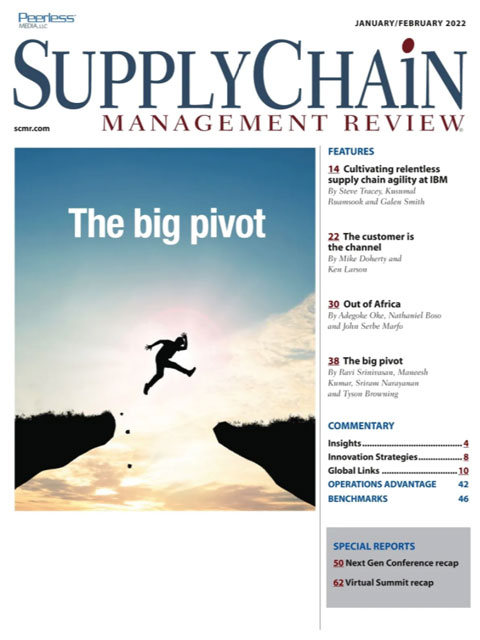Sorry, but your login has failed. Please recheck your login information and resubmit. If your subscription has expired, renew here.
January-February 2022
Well, that’s over, and aren’t we all glad to put 2020 in the rear-view mirror? For a minute, however, let’s look at a silver lining, because I think there is one for supply chain managers. That’s because the pandemic put supply chain in the spotlight like never before—and, with the approval of a vaccine just a few weeks ago in December, supply chain and cold chain are back in the news… While sales usually gets all the attention, maybe 2021 is our time to shine.” That’s the beginning of the column I wrote for the January 2021 issue, and maybe I was a little too pollyannish. Browse this issue archive.Need Help? Contact customer service 847-559-7581 More options
To say that the COVID-19 pandemic has been an unprecedented global event is an understatement. It has affected all aspects of life in most countries. From a supply chain standpoint, it’s difficult to imagine an industry that was not disrupted, and that did not experience unanticipated changes in demand and supply patterns. Shortages of toilet paper may have been the most visible, and personal, but since then, business has experienced shortages of everything from computer chips to the elastic used to make face masks.
When the global economy shut down, few retailers or manufacturers anticipated the dramatic increase in demand that occurred in the middle of 2021. For instance, automotive companies dialed back production capacity only to find shortages of critical components such as microprocessors when they decided to ramp up their production to normal levels. The demand for steel, lumber and home delivery of products increased dramatically as employees working at home decided to spruce up their kitchens, bathrooms and home offices. Companies as sophisticated as Apple were forced to lower their production forecasts for newer models of their phones.
On the consumer side, retailers also had to change their operating procedures to comply with capacity and safety restrictions imposed by the Center for Disease Control and Prevention (CDC) and state and local governments. Customers walking into a store confronted a myriad of dos and don’ts: There were mask requirements, floor markers indicating where to stand to maintain social distancing, plexiglass dividers at checkout stations and hand sanitizers at entry and checkout. For a time, some businesses, such as Trader Joe’s, limited the number of customers in their store at any one time, resulting in customers waiting outside for their turn to enter.

This complete article is available to subscribers only.
Log in now for full access or start your PLUS+ subscription for instant access.
SC
MR
Sorry, but your login has failed. Please recheck your login information and resubmit. If your subscription has expired, renew here.
January-February 2022
Well, that’s over, and aren’t we all glad to put 2020 in the rear-view mirror? For a minute, however, let’s look at a silver lining, because I think there is one for supply chain managers. That’s because the… Browse this issue archive. Access your online digital edition. Download a PDF file of the January-February 2022 issue.To say that the COVID-19 pandemic has been an unprecedented global event is an understatement. It has affected all aspects of life in most countries. From a supply chain standpoint, it’s difficult to imagine an industry that was not disrupted, and that did not experience unanticipated changes in demand and supply patterns. Shortages of toilet paper may have been the most visible, and personal, but since then, business has experienced shortages of everything from computer chips to the elastic used to make face masks.
When the global economy shut down, few retailers or manufacturers anticipated the dramatic increase in demand that occurred in the middle of 2021. For instance, automotive companies dialed back production capacity only to find shortages of critical components such as microprocessors when they decided to ramp up their production to normal levels. The demand for steel, lumber and home delivery of products increased dramatically as employees working at home decided to spruce up their kitchens, bathrooms and home offices. Companies as sophisticated as Apple were forced to lower their production forecasts for newer models of their phones.
On the consumer side, retailers also had to change their operating procedures to comply with capacity and safety restrictions imposed by the Center for Disease Control and Prevention (CDC) and state and local governments. Customers walking into a store confronted a myriad of dos and don’ts: There were mask requirements, floor markers indicating where to stand to maintain social distancing, plexiglass dividers at checkout stations and hand sanitizers at entry and checkout. For a time, some businesses, such as Trader Joe’s, limited the number of customers in their store at any one time, resulting in customers waiting outside for their turn to enter.
SC
MR


Latest Supply Chain News
- Services sector sees growth in October, reports ISM
- Balanced supply chain management Part 4: The key—leading beyond the silo
- Managing inbound freight: What has changed in two decades?
- Inbound freight: Often a missed opportunity
- Aggregators sitting on the throne of Africa’s e-commerce supply chains: What lessons can we learn?
- More News
Latest Resources

 Explore
Explore
Topics
Business Management News
- Services sector sees growth in October, reports ISM
- Balanced supply chain management Part 4: The key—leading beyond the silo
- Managing inbound freight: What has changed in two decades?
- Inbound freight: Often a missed opportunity
- 2024 Warehouse/DC Operations Survey: Technology adoption on the rise
- Benchmarking the complexity of ESG reporting
- More Business Management
Latest Business Management Resources

Subscribe

Supply Chain Management Review delivers the best industry content.

Editors’ Picks





